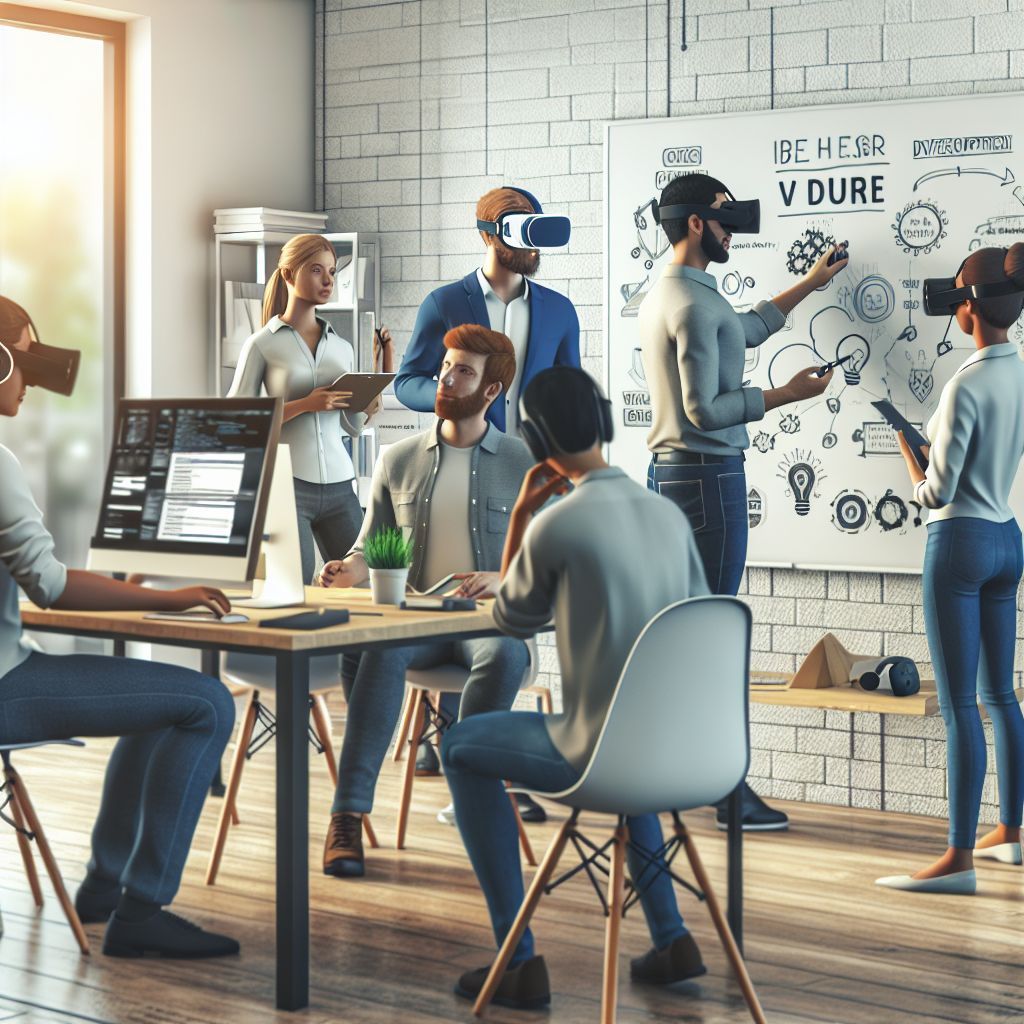Innovative Development of VR, AR, Mobile, and Web Applications

What You Need to Know About the Development of VR Applications

Welcome to the exciting world of Development of VR applications! ⭐ If you’ve ever wanted to dive into a world where reality blurs with imagination, youre in the right place. Today, we explore how mobile and web technologies are revolutionizing the way we interact with digital content through virtual reality (VR) and augmented reality (AR). Did you know that the global VR market is expected to reach a staggering €57.55 billion by 2027? That’s a growth rate of about 44.5% every year! ⭐
The Current Landscape of VR Applications
When we talk about the Development of virtual reality applications, we need to consider various platforms. VR applications can be immersive experiences on mobile devices, or they can be rich interactive environments on the web. Popular industries using VR include:
- Education - Imagine students exploring ancient Rome or conducting virtual chemistry experiments! ⭐
- Gaming - Players are transported into other worlds where they can interact with characters and environments. ⭐
- Real Estate - Tours of properties become digital, providing potential buyers with immersive experiences without leaving home. ⭐
- Healthcare - Medical training can include simulations of surgeries, allowing practitioners to hone their skills in a risk-free setting. ⭐
Why Develop VR Applications?
Developing VR applications is not just about creating engaging content; it’s about solving real-world problems. For instance, an educational institution faced challenges in engaging students in science subjects. By implementing a VR program, students could conduct experiments virtually—this increased engagement by 60%! ⭐
Key Elements of VR Development
As with any technology, understanding the principles of VR development is crucial. Here are some key aspects:
- User Experience: How intuitive and user-friendly is the application? ⭐
- Content Quality: The visual and auditory experiences must transport the user into a new realm. ⭐
- Technical Capability: The application should run smoothly without major technical glitches. ⚙️
- Device Compatibility: Ensure that your VR application works across multiple devices, enhancing accessibility. ⭐
Real-Life Scenarios
Let’s consider Sarah, a high school teacher in search of innovative methods to engage her students. Last year, she adopted a VR platform that allowed her students to explore the solar system. The program was a hit—students showed a 50% increase in knowledge retention! This practical application highlights the true potential of Development of VR applications.
Costs of Developing VR Applications
Youre probably wondering—How much does it cost to develop a VR application? The pricing can vary widely depending on complexity and features. Generally, basic VR applications can start at around €7,500 for mobile platforms. However, as capabilities expand to include 3D graphics, interactivity, and custom development, expenses can increase significantly, with some projects reaching up to €12,000 or more. ⭐
| Type of Development | Estimated Cost (EUR) |
| Mobile VR Application | 7,500 |
| Web VR Application | 10,000 |
| AR Application | 12,500 |
| 3D Graphics Integration | 3,000 |
| Virtual Training Programs | 15,000 |
| Entertainment VR Application | 12,000 |
| Custom Development Components | 2,500 |
| Post-Launch Support | 1,200 |
| Integration with Existing Systems | 5,000 |
| Market Research and Testing | 3,000 |
Call to Action
If you’re ready to join the VR revolution and make a mark in this innovative field, don’t hesitate to reach out! Our team of professional specialists at nexrilo.com is here to help with a full spectrum of services—from development to technical support! Give us a call today at [email protected] or visit our website to discover how we can transform your ideas into reality. Together, let’s create a future you can visualize! ⭐
Frequently Asked Questions
- What is VR development? VR development entails creating applications that allow users to immerse themselves in a digitally simulated environment.
- How is VR different from AR? VR offers a fully immersive experience, while AR enhances the real world by overlaying digital information.
- What technologies are used in VR development? Common technologies include game engines like Unity, VR headsets, and coding languages such as C# and C++.
- Can VR applications be developed for mobile? Absolutely! Many VR apps are designed specifically for smartphones and tablets.
- Is VR cost-effective for businesses? Yes, especially in sectors like training and education where traditional methods can be costly.
- What industries benefit from VR? Education, healthcare, entertainment, and real estate are among the key industries benefiting from VR applications.
- What is the average development time for a VR application? This can vary widely, but simple apps can take 2-3 months, while complex projects may take 6 months or more.
- How can I get started with VR development? Start by researching your target audience, defining your goals, and selecting the right tools for development.
- Are VR applications customizable? Yes, development teams can tailor VR applications to meet specific needs and branding.
- Who can help me develop a VR application? Companies like nexrilo.com offer professional development services tailored to your needs.
How Much Does It Cost to Develop a VR Application? Unveiling Myths and Realities of VR and AR Development

If you’re diving into the world of Development of VR applications, you’re likely asking: How much does it cost to develop a VR application? ⭐ This is a critical question, and the answer can be far more complex than you might assume. The cost of developing virtual reality (VR) and augmented reality (AR) applications has a wide spectrum, and understanding where you fit in can help you budget effectively for your project.
The Cost Breakdown
Development costs can vary significantly based on numerous factors, including complexity, purpose, and platform. Here’s a quick look at how different elements contribute to the overall cost:
-
Platform: Developing for mobile platforms generally costs less than creating for high-end VR systems like Oculus Rift or HTC Vive. For instance:
- Mobile VR Application: Approximately €7,500
- High-End VR Application: Can exceed €15,000
- Functionality: Features such as multiplayer capabilities, 3D modeling, and integration of interactive elements can escalate costs. For example, a simple app may start at around €5,000 but could reach €10,000 or more with additional functionalities.
- Design Quality: Custom graphics and animations can add to your budget. Expect to allocate an additional €3,000 to €5,000 for high-quality visuals and immersive experiences.
Estimated Cost Ranges
To help clarify, here’s a table summarizing common costs associated with different VR application types:
| Type of VR Application | Estimated Cost (EUR) |
| Basic Mobile VR App | €7,500 |
| Advanced Mobile VR App | €10,000 |
| Web-Based VR Application | €12,000 |
| High-End VR System Application | €15,000+ |
| Educational VR Experience | €10,000 |
| Real Estate Virtual Tour | €8,000 |
| Gaming VR Application | €12,000 |
| Multiplayer VR Experience | €15,000 |
| AR Integration Project | €10,000 |
| Post-Launch Support | €1,200 |
Common Myths About VR Development Costs
1. Myth: VR is Only for Big Companies. Many small and medium-sized businesses are successfully leveraging VR for training, marketing, and product showcases. Costs can be tailored to fit a range of budgets!
2. Myth: Development is Quick and Cheap. While basic applications can be developed relatively quickly, well-rounded VR experiences often demand time, skill, and financial resources. Quality doesn’t come cheap!
3. Myth: Once Developed, VR Applications Don’t Require Further Investment. Continuous maintenance, updates, and user feedback incorporation are essential and should be factored into your budget. Investing in ongoing improvements can significantly enhance user satisfaction! ⭐
Real Case Studies
Consider the case of a local education center that sought to engage tech-savvy youth. They opted for a basic VR application costing about €8,000 to create an immersive language-learning experience. After implementation, they reported a 70% increase in student engagement and satisfaction rates! ⭐
On the flip side, a luxury real estate company invested around €12,000 in a high-end VR tour application. The effort paid off as they could sell properties faster and at higher prices, ultimately leading to increased revenues. ⭐
Final Thoughts
Now that weve explored the intricacies of costs involved in the Development of VR applications, its vital to align your budget with your ambitions. Whether youre looking to create a stunning VR experience for mobile devices or a comprehensive web application, planning is crucial. Remember, you’re not just investing in technology; youre investing in an engaging experience that can elevate your business to new heights!
If you’re ready to harness the power of VR and AR, don’t hesitate to reach out to us at nexrilo.com. Our professional specialists can guide you every step of the way. Contact us today at [email protected] or visit our website to get started on your journey to create impactful and engaging VR applications! ⭐
Frequently Asked Questions
- What determines the cost of VR app development? The cost is influenced by platform, functionality, design quality, and project scope.
- Can I get a VR app for a small budget? Yes! There are various options available depending on your requirements.
- How long does it take to develop a VR application? Development time varies; typically, simple apps take 2–3 months, while complex projects could take much longer.
- Is VR development worth it for small businesses? Absolutely! VR can engage customers and enhance marketing, which can drive sales and growth.
- Are there ongoing costs for a VR application? Yes, maintenance, updates, and support are essential ongoing investments.
- What industries benefit the most from VR? Industries like education, real estate, gaming, and healthcare find significant advantages in VR technology.
- How can I measure the ROI on a VR project? One can assess ROI by looking at user engagement metrics, conversion rates, and overall business growth post-implementation.
- Do I need special equipment to develop VR apps? A computer with robust processing power is essential, along with a VR headset for testing purposes.
- Can I monetize my VR application? Yes, many developers monetize through app sales, subscriptions, or in-app purchases.
- Is support important after developing a VR app? Yes, ongoing support ensures the app remains functional and up to date, keeping users satisfied.
Fill out the form below and our team will reach out within one business day
